Houses step by step
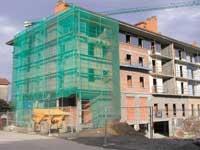
Of course, the first steps are taken in the architecture studio. Once the land is acquired, the developer who wants to build the house and the architect, then goes to the municipal regulations. In fact, the conditions to be met pass from the town to the town: maximum slope of the houses, width, buildable perimeter in each plot, slope of the roof, maximum number of houses, etc. Taking into account all these conditions, the architect elaborates and presents a detailed study, that is, physically situates the building, which once approved begins to materialize.
The design works of the buildings are divided into two main projects: the basic project and the execution project. The first step is to define the plant, elevations and sections. The execution project then defines the structure of the building, which would be the skeleton of the human being, determining the location and shape of the foundations, pillars, beams and plants. These will be the ones who will resist the house, so you have to work fine.
Foundations
The function of the foundations is to maintain the load of the building and transmit it to the ground. More or less buried and currently concrete.

The architect decides the foundation according to the loads of the building and the characteristics of the terrain. Uncompacted, sandy or very high groundwater soils have little capacity to withstand loads and are bad for construction. In these cases, the architect is aware that he will not be able to cement with traditional shoes and that he will have to put balls to the bottom.
In this phase, architects collaborate with geologists, since in all projects is essential the geotechnical study of the department.
Lots of documents
However, just as there are veins, tissues and organs around the human skeleton, the structure of the building is surrounded by pipes and fibers of electrical installation, sanitation, heating, etc. In the project of execution, therefore, together with the plans of the structure, the plans of all these facilities are elaborated. In addition, the safety and health studies, the memory with all the work to be done and the specifications of technical conditions. The latter details the materials to use and their characteristics. Once all analyzed and approved, housing will move from paper to reality.
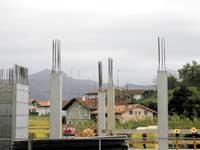
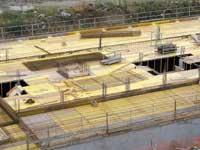
This is when the work of the surveyor begins. The topographer marks on the ground what was done on paper by the architect and uses ropes to the operators of the work to indicate where each element of the structure will go.
Reinforcements, pillars and ceilings
Once the foundations are fixed the base of the house is made. To do this, through beams the shoes or piles are joined together and, in the next step, the perimeter is covered with concrete. Not everything is covered, leaving in sight the steel wedges of the foundations, where will fit the wedges that will be the armour of the columns.
Like foundations, column supports are usually steel wedges. The square columns consist of four blades and the circular six. And as we have already said, they fit into the wedges of the foundation. Once all the paddles are placed and the reinforcements formed, to give it the shape of a column they shrink, that is, they are framed of wood and filled with concrete but not entirely. The top tips of the paletons should be left in sight, where the reinforcements of the pillars of the next floor will fit.
In most cases the columns have the same height as the plants and are made in the work itself. However, pre-built pillars are also used in buildings with few or one floor. In these cases, the columns fit into the gap left in the foundations, but to withstand large loads steel plates attached to the column armor are used to make more strength. If prefabricated pillars are used, buildings of up to four floors can be built.
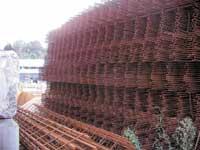
Once the columns are finished the beams are placed. As in the pillars, the number and thickness of the beams will vary depending on the load to bear, but in the case of the beams there is no formwork, since they are normally recessed inside the ceiling.
However, the resistance of the beams is usually not enough to withstand the weight of the ceiling, since in addition to the load of the house, the ceiling must withstand the overload of furniture and neighbors. To ensure this, the beams of each plant are joined together by steel sticks to form a horizontal mesh armor. Then we proceed to the concreting, always exposing the studs of the columns, from which the construction of the next plant will start. All floors are built equal, including the roof.
Walls


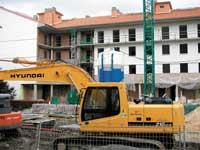
Once the structure is finished, the masons begin to work. Before you start dressing the building you have to make walls, both exterior and interior. However, it is not the same to build exterior walls as interior walls of the building; in the interiors, it is not the same to do interiors or between houses. The material may be the same, but not the thickness, coating, insulation…
Both bricks and blocks should not be placed so that the joints of a row are joined to those of the top or bottom, but are broken. Taking this into account, the image to be realized will depend on the needs (aesthetic, practical, economic…).
On the other hand, on many occasions in the exterior walls and in some walls between houses, the air chamber is left, which isolates it better than the compact walls of the same thickness. However, the walls between rooms or rooms are usually thinner and of a single layer of brick (in recent years the pladur is also increasingly used). However, the main interior walls or load walls are more resistant and, of course, are not plasterboard.
If everything goes as you like, the other guilds begin at the same time that the masons begin to work. First, the sanitation, the electrical system and the heating system of each house will be organized and then slabs and tiles will be placed, the floor will be covered with wood, kitchen utensils will be placed, the walls will be painted and everything will be cleaned. Although not mentioned above, the general sanitation system of the building is carried out in conjunction with the base, unless the water table is above the base.
When the work is in its final phase, the architect elaborates the plans of end of work. In these plans the architect collects all the changes that have occurred in the construction process, since it is very common that on the road from paper to reality there are unforeseen and takes them to the college of architects along with the photographs of the work. If all inspections are exceeded, the house is given the habitability cell and the owner the keys.
If chance has bet on you, that will happen for two years, if it has been against, instead...
Shoes or piles to cement

The function of the foundations is to maintain the load of the building and transmit it to the ground. More or less buried and currently concrete. They are made with shoes or balls if the ground is soft.
Shoes can be traditional linear (apaisated), deep linear (vertical) or slabs. In any case, they can be made of pure concrete or reinforced concrete, that is, with steel reinforcements inside. When there are no suitable conditions for the realization of the shoes, balls of different length and width are used depending on the load to bear and the surrounding terrain. Like the shoes, they can be made of pure or reinforced concrete, as well as wood and steel depending on the building. They can be made by digging into the ground and concreting, injecting the concrete under pressure or by pre-doing with hammers on the ground.
On shoes and piles are placed columns or walls and, if applicable, walls of containment are made on shoes, concrete or brick.





